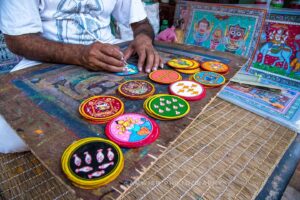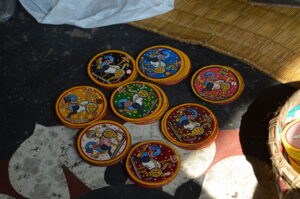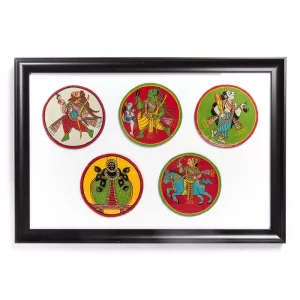With its intermingling hue

s of colours that bring the ferocious and the benevolent gods and mythical beasts of lore to the tangible surfaces, the art of ‘Patta Chitra’ executed over the ganjapa cards represents a unique expression of gameplay that has a history of acculturation and transformation in India. Etymologically, the name ganjapa or ganjifa is derived from the word ‘gunj’ meaning in Persian as a ‘treasury’ or ‘currency’. The acute retracement of the word from Persia signifies its history that is aligned with the advent of the Mughals in India. As their empire consolidated its position, the game of ganjifa spread in the corners of their dominion, becoming a significant part of their daily social life. Its entrance into the region of Odisha led to certain alterations that were first made evident in the depictions that earlier adhered to the Islamic calligraphy and were changed to more palatable designs of the Hindu divinity. Even a slight revision was also enacted in its name that was changed from ganjifa to ganjapa.
Traditionally the cards were in eight suits that were subdivided further into two groups of four suits each that slowly underwent certain alterations with an increase or decrease in suits consisting of a pack of seven, eight, nine, ten, twelve, sixteen and twenty-four suits. Based on the assigned numbers in the packs they are thus named saptamatrka or satarangi (7 suits), athrangi (8 suits), nagaraha (9 suits), dasarangi (10 suits), sohalarangi (16), chaubisirangi (24), in which ranga signifies the colour while the prefix is the number.

The manufacturing process of the ganjapas revolves around a tedious and complex procedure, in which the base is prepared first with stacked clothes conjoined together with crushed tamarind seeds paste. The chalk paste, applied at the front with necessary polishing to make the surface smooth for painting, is undertaken to prepare it for the final stage of filling colours. All the colours employed for depicting the decorative motifs of the deities are made using natural pigments such as white is procured from the shell, red from hingula stone, yellow from haritala stone, orange from geru, while black is extracted from charcoal or collected soot. The general shape of the cards is circular (cakā sāra) with variability in its dimensions that extends from 2.5 to 4 inches against the often rare shapes of rectangular or oval proportions. The ganjapa cards are mainly modelled by the vaishyas with Mohapatra or Maharana dominating this craft in the region of Odisha.
Being centred in the religiously vibrant city of Puri, where most of its existing players reside, the playing cards have thus also experienced intrinsic influences from the religious landscape of this region with many of its motifs (harphas) manifesting the imagery of Jagannath or figures from the Vaishnavite sect. Treatment of other deities also persists which are often made prominently based on their regionality such as in Raghurajpur (near Puri) and Puri as centres known for its Dasavatara ganjapa, Chikitigada in Ganjam district for its krishnashtamalla, and Paralakhemundi in Gajapati district with cadeisara motifs while Subarnapur district being distinctively known for its Ramayana cards.
 Infiltration of secular imagery into an otherwise religious one is also initiated, subsuming the depiction of the divinity and replacing it with the standing portraits of the Kings, Ministers, and soldiers who are made ornate with their associated attire and weaponry. Distinction in the status in this hierarchy is portrayed through variations in schemes of their colour and form as per their specified suits. Images of Nabagunjara (a composite mythical animal of nine beasts) are also drawn which may indicate the associated character of the ministers possessing myriad talents. However, the motif of the mythical beast is quite rare to find and is only available in the repository of a select few collectors.
Infiltration of secular imagery into an otherwise religious one is also initiated, subsuming the depiction of the divinity and replacing it with the standing portraits of the Kings, Ministers, and soldiers who are made ornate with their associated attire and weaponry. Distinction in the status in this hierarchy is portrayed through variations in schemes of their colour and form as per their specified suits. Images of Nabagunjara (a composite mythical animal of nine beasts) are also drawn which may indicate the associated character of the ministers possessing myriad talents. However, the motif of the mythical beast is quite rare to find and is only available in the repository of a select few collectors.
Chiefly the occupation of playing the card is attested in the hands of the ‘sebayats’ or the servants of Jagannath at Puri. Panḍās (temple priests), the cooks of the prasāda (meals prepared for the presiding deity at Puri) or other temple associates are the major players in the game while lower menials are excluded from participation. While no religious significance is generally attested in playing the game, however, people claim a psychological contentment from invoking the name of the lord as depicted on these cards that usually redeems them from the sins committed earlier and consider it equivalent to the expression of a jaapa (chanting).
However, with the nascent dependence on modernism and Western consumerism gradually encompassing the whole of India, the art and the expression of immersing in these games have reached a precarious situation, being replaced with an influx of Europeanised cards along with the rules and regulations that are central to the Ganjapa game traversing towards oblivion. Being expensive in cost, these cards are failing to meet the adverse competition posed by the mechanically produced plastic cards with the remaining centre of production limited to Raghurajpur (Odisha) which still maintains the traditional technique of its craftsmanship. The game thus is negligibly played in certain parts of India some of which include Sawantwadi in Maharashtra; Puri, Ganjam, Gajapati, and Subarnapur districts in Odisha; and Nirmal in Andhra Pradesh.

